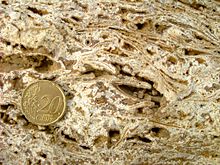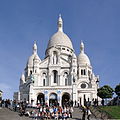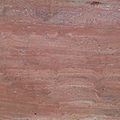Travertine

Travertine (of Italian travertine , Latin lapis tiburtinus , "stone from Tivoli ") is a more or less porous limestone of lighter, usually yellowish and brown or rare beige or red color, the chemical from cold, warm or hot freshwater springs as Quellkalk precipitated was . The sources include calcium - and hydrogen - ion and carbon dioxide , the travertine itself consists almost entirely of calcium carbonate . It is a freshwater lime .
Demarcation
Travertines are clearly layered, solid and polishable rocks . If they are sawn against their storage direction, travertines show an easily recognizable banding. As Kalktuffe be "highly porous to cavernous and partly solidified, not marine carbonate rocks" means. If the terms Kalksinter and the terms used for the sub-terms Kalktuff and Travertine are used synonymously, confusion arises. Limestone tuffs are not clearly layered, show partially uniform surfaces, partially have large cavities and partially show fossilized plants and small animals such as snails. Limestone tuffs also form cauliflower-like surface structures and are not banded. Lime tuffs are often loosened and only partially solidified. They cannot be polished. In break damp condition they can be shaped with hand saws and knives. This is not the case with travertines. Both rocks are among the soft rocks . In the natural stone processing trade in Germany, the tufa Gauinger travertine is known as travertine. It was so named because it is a tufa that is firm and polishable.
Designations
Different names are used for limestone tuffs in both geological terminology and colloquial language. Tuff , travertine and sintered lime are used to differentiate or synonymously. In technical terms, travertine is the tufa limestone that is formed by the escape of CO 2 from CO 2 -saturated spring groundwater. This process is known as chemical decalcification .
The names for travertine are often regional or linguistically different (depending on the occurrence):
- In southwestern Germany cuesta landscape precipitations in to caves ( stalactites ) as travertine referred. Precipitation behind karst springs , or in turbulent or tumbling water from brooks and rivers as tufa .
- The recent formations, but also the results of diagenesis (fossilization) behind cold springs are called tufa . (No resemblance to volcanic tufa !)
- The term travertine is common in English .
The artificial stone travertine, which consists of colored cement and debris, is not a natural stone .
education
Waters that contain carbon dioxide (CO 2 ) in relatively high concentrations are also characterized by relatively high concentrations of hydrogen carbonate ions (HCO 3 - ) and a relatively low pH value below five. Calcium ions (Ca 2+ ) can also be dissolved in higher concentrations in them because the solubility product for calcium carbonate (CaCO 3 ) is not achieved due to the very low concentration of carbonate ions (CO 3 2− ). If such water emerges and equilibrates with the very low CO 2 content of the air or if it is heated, CO 2 escapes . The pH value increases, the concentration of hydrogen carbonate ions decreases and that of carbonate ions increases. If the water contains calcium ions (Ca 2+ ), the solubility product of calcium carbonate is exceeded and the calcium ions precipitate out as calcium carbonate together with the carbonate ions formed in this way. The solubility product of calcium carbonate ( calcite ) is at 15 ° C 0.99 × 10 -8 at 25 ° C 0.87 × 10 -8 (mol / L) 2 .
Waters can be enriched with dissolved CO 2 by supplying CO 2 from volcanic and post- volcanic degassing and thereby acidified, and they can thus dissolve calcium from rocks, especially from limestone, if they seep through the rocks. In this way they become potential travertine formers: When they come to the surface of the earth in springs and / or are heated, CO 2 escapes and calcium carbonate precipitates as travertine.
“Cold” springs are more significant for the emergence of travertines than from hot springs. The water is usually heated when it emerges on the surface, and the lime dissolved in the cool water precipitates in the immediate vicinity of the source and forms rock deposits. With a small amount of limonite , travertine can be yellowish to brown in color, with hematite it can be reddish to red, often stratified with different intensities, banded in the cut.
The limestone is deposited oolithically from some thermal springs, so-called " pea stone " is then formed , for example in Karlsbad , Czech Republic.
Recent travertines usually develop abiotic, i.e. without the involvement of living beings, if the solubility product for calcium carbonate is exceeded by the formation of carbonate ions (CO 3 2− ) due to the escape of carbon dioxide . The photosynthetic activity of algae or moss in the water can have a beneficial effect due to the consumption of carbon dioxide.
Occurrence
Travertine is quite common on the continents. The occurrences are usually very limited and relatively sparse. For its deposition, it needs the immediate vicinity of older limestone or marble deposits from which the carbonate originates. In most cases, travertines are very young rocks that were formed in the Quaternary .
Well-known deposits in which ashlars are extracted are:
- in Germany
- Thuringia: for example the Langensalza travertine in the Thuringian Basin , Weimar-Ehringsdorf , Bilzingsleben, Mühlberg and in Jena (Pennickental)
- Baden-Württemberg: e.g. Cannstatter Travertine in the Stuttgart district of Bad Cannstatt and Gauinger Travertine near Gauingen
- in Europe
- Czech Republic : Mineral springs from Karlsbad , which was already described by Johann Wolfgang von Goethe .
- Italy : Roman travertine in the Tivoli area (the building blocks for the Colosseum and St. Peter's Church in Rome are from here); also at Alcamo (Sicily) and Travertino Toscano near Rapolano Terme in Tuscany
- France : in the Auvergne
- Croatia : in the Plitvice Lakes National Park ,
- Bulgaria : by Russian
- Slovak Republic : near Spišské Podhradie and Vyšné Ružbachy
- outside of Europe
- Turkey : near Pamukkale , Çankırı (province) and Kayseri (province)
- Armenia : near Abovyan
- China : Jiuzhaigou
- USA : Mammoth Hot Springs in Yellowstone National Park (Wyoming), Mono Lake
Recent travertine formation occurs in areas with volcanism or post-volcanic CO 2 degassing, especially where high-temperature water occurs. Examples of such travertine formation are Tuscany, Italy; Pamukkale, Turkey or the Mammoth Hot Springs, Yellowstone National Park, Wyoming, USA.
Travertine terraces near Pamukkale , Turkey
Travertine terraces of Mammoth Hot Springs , Yellowstone National Park , Wyoming, USA
The Parisian church of Sacré-Cœur de Montmartre from Château-Landon- Travertin
Mühlhäuser Marienkirche made of travertine
The largest castle complex in Central Europe, the Spis Castle , was built from travertine from the nearby deposit
Properties and use

Travertine is mostly porous and interspersed with cavities. Often it includes plants and plant parts in its formation, which are then decomposed. The resulting cavities often still show the external structure of the plant parts. If the lime precipitation continues afterwards, the cavities can possibly still be closed, and the travertine becomes stronger and easy to work with. Travertine in its natural occurrence is easy to break and saw. Solid travertine has a density of about 2.40 g / cm³ and a compressive strength of about 50 megapascals , it is suitable for grinding and polishing and thus as a building block, for decoration (facades, door and window frames) and for fixtures in buildings. Despite their high water absorption of 0.3 to 3.0 percent by mass, travertines are frost-resistant. Due to the currently prevailing acidic environmental conditions, the surface is weathered relatively quickly. Travertines, which are particularly dense, can be polished. This also applies to all travertines if they are sawed open with the bearing and polished. In the weathered outdoor area, a polish disappears in short periods of time and a matt patina develops, which has its charm.
In construction , travertine is used as a natural stone and for decoration . It is traded open-pored or filled .
Despite its comparatively low strength , travertine was valued in earlier times because of its low density (light weight) and easy workability , for example for churches and city walls. Travertine was mainly used regionally around rich deposits as a building block. In central Thuringia you can find churches, city walls or other buildings made of this material in almost every city today. The tallest travertine structure in Germany is the Marktkirche St. Bonifacius (Bad Langensalza) with a 72.49 or 73.6 meter high bell tower, depending on the measurement method. In Rome, the pillars of St. Peter's Square are made of Roman travertine , which was broken mainly at Tivoli.
Roman master builders liked to use travertine types for the foundation masonry of high-rise buildings, depending on availability, because its open-pore structure results in a high evaporation surface and the base area was thus permanently drained in a natural way.
Natural stone types
- Germany
- Cannstatter Travertine ( Bad Cannstatt , Baden-Wuerttemberg)
- Langensalza Travertine ( Bad Langensalza , Thuringia)
- Italy
- Roman travertine ( Italy, Tivoli near Rome)
- Travertino Toscano ( Tuscany , Italy near Rapolano Terme )
- Other countries
- Hanácký travertine (near Tučín , Moravia , Czech Republic), mining stopped
- Üröm (near Budapest , Hungary)
- Spiš (near Spišské Podhradie , Slovak Republic)
- Denizli Yellow ( Anatolia , Turkey) different varieties
- Persian travertine ( Iran ), East Azerbaijan , near Maragha , different colors
See also
literature
- Esther Helena Arens, History Office Reder, Roeseling & Prüfer: Stones with History: 100 Years of Traco Deutsche Travertin Werke 1907–2007 , ed. v. Traco, Rockstuhl, Bad Langensalza 2007, ISBN 978-3-938997-99-4
- Andreas Fehler: The travertines of Bad Langensalza , Rockstuhl, Bad Langensalza 1998, ISBN 3-932554-32-9
- Dietmar Reinsch: Natural stone studies. An introduction for civil engineers, architects, preservationists and stonemasons , Enke, Stuttgart 1991, ISBN 3-432-99461-3
Web links
Individual evidence
- ↑ a b Wolfgang Werner, Roman Koch: Kalktuffe . In: Natural stone from Baden-Württemberg - occurrence, procurement and use , p. 317. Ed. State Office for Geology, Raw Materials and Mining. Rüsselsheim 2013. ISBN 978-300-041100-7
- ↑ Dietmar Reinsch: Natursteinkunde, p. 161, see Ref.
- ↑ Johannes Baier: The Cannstatter Travertine . Aufschluss, Vol. 71, 2020, pp. 144–153.
- ^ Johannes Baier: Goethe and the thermal springs of Karlovy Vary (Karlsbad, Czech Republic) . Annual reports and communications of the Upper Rhine Geological Association, N. F. Vol. 94, 2012, pp. 87–103, doi: 10.1127 / jmogv / 94/2012/87 .
- ^ Friedemann Mertin: Church towers in Thuringia: Marienkirche Mühlhausen towers above all. April 20, 2019, accessed on February 16, 2020 (German).















